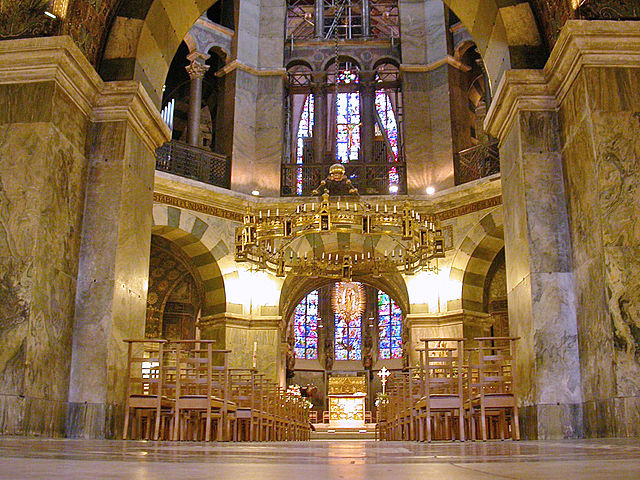The Medieval Church Conundrum: How the Gospel was Preserved and Spread from the Frontiers
When the Empire made the Church into one of its institutions, how could the radical good news about Jesus the Christ continue to break out and change lives? Part of The Gospel in History series.

Charlemagne’s palace chapel was completed in 805 CE and later incorporated into the Aachen Cathedral, the oldest cathedral in northern Europe.
Image: Tobias Helfrich / Wikimedia Commons
Conundrum is a strange adjective, yet it is appropriate when one considers the state of the Christian message from AD 385/400 to 1452. The Edict of Milan (AD 313) ended the persecution of Christians and brought an era of peace for the Church. A tenuous relationship between the Christians and the ruling empire emerged. From AD 350 until 378, the year of the Battle of Adrianople, an increasing flood of invaders from Eurasia and from north of the Danube poured into the Mediterranean world. Some of the newer peoples integrated with existing populations and served in both the Roman and Byzantine armies. Some did not.
Increasingly, the Roman system destabilized and the only stability that existed was furnished by the diocesan system of the Christian Church. By the time of Augustine, the Bishop of Hippo, Germanic peoples had crossed both the Danube and a frozen Rhine river. Those who crossed the Danube went southward into the Balkans and eastern Italy. Those crossing the Rhine swept westward into Gaul, the Iberian peninsula, and south into northwestern Italy all the way to Rome. Vandals and Alans crossed over the straits of Gibraltar into Northern Africa and moved westward to capture Carthage. The unsettled conditions, in large part, prompted Augustine to compose his masterful Civitate Dei (The City of God).
The expansion of the good news in the medieval age often happened where the influence of the church was weakest.
Further muddying the waters of Christianity was the rise of Islam from the teachings of Mohammed in the seventh century. Islam armies swarmed out of the Arabian deserts, invading Persia to the northeast, Syria to the north, Byzantine areas northwest, and west across North Africa from the Sinai to what is now Morocco, and north into southern Spain. The armies devastated churches and massacred whole populations. The massacres prompted Christian leaders in Europe to strike back against the invaders who were sweeping into the Iberian peninsula and thrusting northward into the land of the Franks. This defensive movement, since known as the Crusades, had the purpose of driving the marauding Islamic forces out of southern France, out of the western Mediterranean, and out of the Holy Land. Among the supporters was Bernard of Clairvaux, an eminent Christian monastic scholar. It was a long, drawn out effort that lasted from the eighth century into the eleventh and twelfth centuries. The Crusades were, by no means, an offensive action as some scholars have interpreted them from John Julian Norwich to the present. Only recently, under the pains-taking scholarship of Rodney Stark, have the Crusades come to be seen as a defensive reaction.
Category: Church History, Winter 2016


